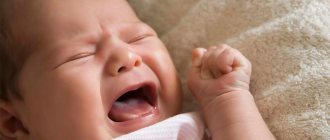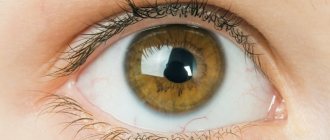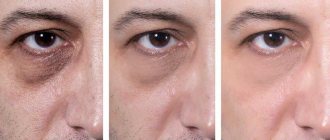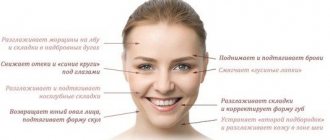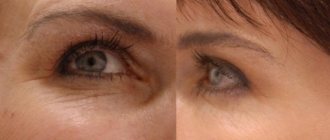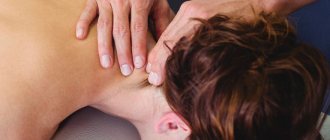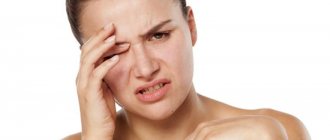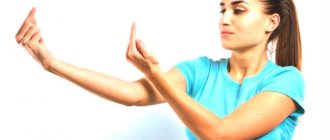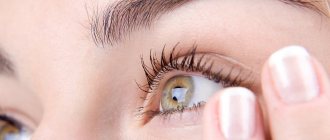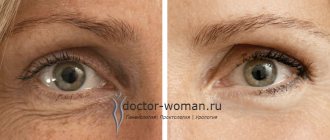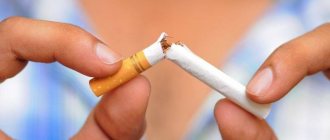The early stages of glaucoma are usually asymptomatic, followed by redness and pain in the eyes, high intraocular pressure, blurred vision and several other unpleasant symptoms. It must be treated, since it does not go away on its own and without proper therapy can lead to blindness. The last stages are treated only with surgery. In the early stages, you can use a method such as acupuncture. The essence of the method is to pierce certain points on the body and face with needles. At the same time, medications are used in the form of drops or medications.
In this article we will talk about some types of acupuncture for glaucoma, its advantages and disadvantages, as well as about the disease itself and other treatment methods.
Glaucoma
Glaucoma Source: сelt.ru Glaucoma is a disease that causes damage to the optic nerve and, as a result, leads to visual impairment or blindness.
This disease can occur at any age, starting at birth, but is most common in older people and older adults. Currently, there is no common understanding of the causes and mechanisms of development of this disease.
Glaucoma usually occurs due to increased intraocular pressure (IOP). At the front of the eye, between the lens and the cornea, there is a small space called the anterior chamber. A transparent liquid circulates in it, washing and nourishing the surrounding tissues.
When intraocular fluid begins to flow too slowly from the anterior chamber, its accumulation causes an increase in intraocular pressure. If left unchecked, it can cause damage to the optic nerve and other structures of the eye, leading to vision loss.
Types
Open angle glaucoma. This is the most common form of glaucoma. Intraocular fluid flows through the angle of the anterior chamber, which performs a filtering function in the eye, very slowly, which leads to an increase in ocular pressure. This angle between the cornea and the iris is of medium width or open.
Angle-closure glaucoma. The outflow of intraocular fluid from the eye is blocked due to the fact that the structures of the eye cover the narrow angle of the anterior chamber. Closure of the angle can be primary (due to the structural features of the UPC) and secondary (caused by some disease).
This can trap aqueous humor inside and lead to increased intraocular pressure. However, the presence of a closed anterior chamber angle does not mean the presence of glaucoma. This diagnosis is established only in the presence of characteristic changes in the fundus - glaucomatous optic neuropathy.
In case of an acute attack of glaucoma, emergency medical attention is required. The attack must be stopped as quickly as possible to prevent visual impairment and blindness.
Normal pressure glaucoma. The optic nerve is damaged even when intraocular pressure does not increase. This form of glaucoma is the least studied.
Congenital or childhood glaucoma. This form of glaucoma is detected immediately after birth or during the first 5 years of life. It is usually associated with a pathology in the eye that slows down the normal flow of intraocular fluid.
Pigmentary glaucoma. A rare form of glaucoma associated with the deposition of iris pigment, which clogs the filtering angle of the anterior chamber and thereby impedes the outflow of intraocular fluid. The resulting inflammatory process in the blocked corner causes damage to the drainage system.
Secondary glaucoma. This type of glaucoma develops as a complication of another pathology, such as a tumor, inflammation, diabetes, eye injury, or long-term corticosteroid therapy.
Pseudoexfoliative glaucoma. With pseudoexfoliative glaucoma, flake-like layers (pseudoexfoliation) are deposited on the posterior surface of the cornea, the ciliary body, the iris and in the iridocorneal angle of the anterior chamber.
Neovascular glaucoma
This pathology is associated with iris rubeosis (pathological growth of blood vessels in the iris). Newly formed vessels block the outflow of aqueous humor from the eye, causing a rise in intraocular pressure.
Iridocorneal endothelial syndrome. This rare form of glaucoma usually develops in only one eye. Cells from the posterior surface of the cornea spread into the drainage zone and throughout the entire surface of the iris, causing increased intraocular pressure and damage to the optic nerve.
Treatment of eye diseases
Almost all pathologies associated with the eyes, for example, degeneration, dryness, ametropia, thrombosis, the initial stages of glaucoma, myopia, can be treated through ocular acupuncture.
Additional treatment results can be achieved using a combination of eye acupuncture and the SANUM therapy method. Thus, this therapeutic model is used both for the treatment of ocular pathologies and for the elimination of pain. But even combined treatment will not help restore already destroyed tissue, so therapy should be carried out in the first stages of the disease.
Unfortunately, eye pathologies often remain incurable, but it is possible to improve health and significantly slow down the progression of the disease. Sometimes it is not possible to completely restore vision and restore its sharpness. Thus, myopia in a person after twenty years of age or actively progressing glaucoma is not amenable to therapeutic intervention. This may require surgery.
Sometimes specialists refuse to organize cataract surgery due to the low chances of achieving a positive result in patients with glaucoma. To eliminate obstacles to the operation, it is initially necessary to organize eye acupuncture.
Rate this article:
(No votes yet)
Loading...
Related posts:
- How is acupuncture useful and what is its mechanism of action?
- Korean acupuncture: how it works
- How does the acupuncture point locator device work?
- Basics of Triorigin Acupuncture
- Is acupuncture effective for bronchial asthma?
- Eliminating wrinkles with cosmetic acupuncture
Symptoms of the disease
Source: Glaza.guru In the early stages, most cases of open-angle glaucoma are not accompanied by any symptoms or manifestations: normal vision remains, there is no pain or other changes in well-being.
Sometimes patients may complain about the temporary appearance of rainbow circles before the eyes, the phenomenon of asthenopia. Since they are not signs specific only to glaucoma, this may lead to underestimation of the condition and, as a result, a delay in diagnosing the disease.
However, although there are no symptoms in the early stages of the disease, irreversible damage can occur to the optic nerve.
If glaucoma remains undetected for a long time, the symptoms described below may subsequently appear. The main one is deterioration of peripheral vision. A person sees well straight ahead, but may not notice objects located to the side and at an angle.
Initially, the narrowing of the field of vision occurs mainly from the side of the nose, and later it can concentrically cover the peripheral parts until it is completely lost. It is also possible that a translucent or opaque spot may appear in the field of view.
The patient may notice a decrease in dark adaptation, consisting in deterioration of vision when quickly moving from a brightly lit room to a darkened one, as well as, sometimes, the appearance of color vision disturbances.
In some cases, an uncorrectable decrease in visual acuity is observed, which already indicates a severe, advanced stage of the disease, which is accompanied by gradual atrophy of the optic nerve fibers.
The most striking symptoms are observed during an acute attack of angle-closure glaucoma. In this case, the following manifestations of the disease may be detected:
- pain in the eye and headaches radiating along the trigeminal nerve (frontal, zygomatic, temporal regions);
- blurred vision;
- rainbow circles around light sources;
- photophobia;
- redness of the eye;
- nausea and vomiting;
- decrease in heart rate.
It should be noted that often the general symptoms are more pronounced than the ocular ones. Patients are often restless, in some cases they may experience pain radiating to the heart and abdomen, similar to the manifestation of cardiovascular pathology.
Slit lamp examination reveals corneal opacity due to edema. The pupil is greatly dilated, the reaction to light is sharply weakened or absent. On palpation, the eyeball is hard as a stone.
All of the above symptoms of an acute attack of glaucoma require emergency medical attention. If the pressure is not reduced with medication or surgery within the next few hours after the attack develops, the eye faces permanent loss of vision!
Indications and contraindications
Procedures are indicated for restoring vision, treating myopia and farsightedness, relieving fatigue and tension, and preventing age-related deterioration of the muscles of the eyeballs.
It is also recommended for eye diseases:
- Dry eye syndrome;
- Retinal dystrophy;
- Barley;
- Chalazion;
- Blepharitis, etc.
Contraindications for massage sessions:
- Recovery period after laser vision correction;
- Severe condition due to colds and viral diseases;
- Mechanical damage to the eyes;
- Damage to the skin in the eye area;
- Severe myopia;
- Decompensated glaucoma;
- Neoplasms in the eyes and brain;
- Bleeding and blood diseases;
- Hypertension 3 degrees;
- Open form of tuberculosis;
- Migraine;
- Fatigue of the central nervous system.
It is recommended to avoid massage if you have elevated body temperature or dizziness.
Diagnostics
Source: proglaza.ru The main problem in diagnosing glaucoma, primarily open-angle glaucoma, is the absence of typical symptoms in the early stages.
Many people who have this disease are unaware of it. Therefore, it is very important, especially in old age, to undergo regular examination by an ophthalmologist. There are several methods for diagnosing glaucoma. Eye pressure is measured using tonometry. Checking eye pressure is an important part of diagnosing glaucoma. High intraocular pressure is often the first sign of the disease. In some cases, anesthetic drops are placed in the eyes before the measurement.
Using a special device - a tonometer - the resistance of the cornea to pressure is measured. Intraocular pressure is considered normal from 10 to 21 mm Hg. (P0-true).
However, in people with normotensive glaucoma, in which IOP is less than 21 mmHg. Art. Optic nerve damage and visual field loss may occur.
Gonioscopy (examination of the anterior chamber angle) allows you to get a clear picture of the condition of the anterior chamber angle of the eye to determine the type of glaucoma. This is difficult to do during a routine examination.
Using a mirror lens makes it possible to examine the anterior chamber angle and determine the presence of open-angle or closed-angle glaucoma or a dangerous narrowing of the anterior chamber angle (when the iris is so close to the drainage system of the eye that it can block it).
Ophthalmoscopy (examination of the optic disc for signs of damage) is performed using an ophthalmoscope, an instrument that allows you to view the internal structure of the eye under magnification. The pupil is dilated using special drops.
Glaucoma damages the optic nerve, causing the death of its fibers. As a result, its appearance changes, it begins to resemble a bowl. If its size increases, “dark” spots appear in the field of vision.
Perimetry reveals “dark” spots in the field of view. The test results will show their presence and location. The patient may not even notice some of them. The test is performed using a cup-shaped instrument called a perimeter.
Only one eye can be tested at a time, so the other eye is covered with a bandage during the test. The patient must look directly at the mark. The computer gives a signal and luminous points flash inside the device in a random order.
The patient must press the button when he sees them. Not every sound signal is accompanied by the appearance of a dot. Perimetry is usually performed every 6-12 months to monitor changes.
Pachymetry is the measurement of corneal thickness. This indicator may affect the accuracy of IOP measurement. If the cornea is very thick, then the intraocular pressure will actually be lower than what is measured by tonometry. Conversely, with a very thin cornea, the true intraocular pressure is higher than the measurement result indicates.
Massage around the eyes
The following movements need to be done with your fingertips. Particular attention should be paid to painful points located on the brow ridge. After that, move on to the bottom of the eye socket.
The next exercise is to massage the outer corners of the eye, then pay attention to the inner corners of the eye. Move to the bridge of your nose and move along the nasal arch with a vibrating movement. The nasal canal is located in this place, and its vigorous massaging can reduce congestion in the sinuses.
Vigorous massaging of the nasal canal also affects the quality of vision
Then start massaging your sinuses. They are located under the eyes, on the lower arch of the orbit. Experts say that these are biologically active points that increase overall tone. Of course, there is another sequence for processing points. It is shown in the photo below.
You need to perform the exercise one by one
The massage should be completed by gently pressing your palms on the eyeballs. The exercise should be repeated 5-7 times.
Glaucoma Treatment Methods
Treatments for glaucoma include eye drops, tablets, laser surgery, traditional surgery, or a combination of these methods. Their goal is to prevent permanent vision loss due to glaucoma.
The main goal of treatment is to reduce IOP to an acceptable level, which is achieved in two ways: reducing the production of intraocular fluid and improving fluid outflow.
Important
Optimism is inspired by the fact that the course of glaucoma can be controlled if it is detected early, and thanks to conservative and/or surgical treatment, most patients with glaucoma do not lose the ability to see.
Treatment tactics for glaucoma depend on its type, cause of development, and severity of the disease.
Acupuncture points
In each part of the brain and spinal cord, nerves begin that extend in a certain order to all areas of the human body. Each of them contains somatic and vegetative (sensitive and motor) components that serve as conductors.
Some parts of the nerve end in the capsule of the organ or in the organ itself, others branch through the subcutaneous tissue and lower layers of the skin, performing the role of collecting information.
If there is damage in some place of the body, all parts of the conductor react to it. So the branches of the trigeminal nerve go to the eyelids and the nasal mucosa.
Acupuncture points are branches of nerves located in the subcutaneous tissue and skin. These active points are localized over the surface of the body with different densities. A certain impact on them sends a signal to the spinal cord.
From there, another signal is returned with information about the normal operation of the organ. Thus, it becomes possible to send health signals to the diseased organ. The healers of ancient China connected active points into conventional lines - meridians responsible for a specific organ.
There are several thousand acupuncture points on the surface of the body. They vary in size, but generally their diameter does not exceed a few tenths of a millimeter.
Finding a point, knowing its Chinese name and modern designation, remembering which of them is responsible for the work of a certain organ, not confusing the list and order of influence on them, and determining the number of necessary sessions and courses for a person not initiated into the art of Zhen-Jiu seems impossible.
Lymphatic drainage massage
Based on the name, it is obvious that the purpose of the procedure is to stimulate the movement of lymph. This type of massage should not be considered solely a cosmetic product. The result of the course is not only smoothed wrinkles and reduced swelling under the eyes, but also increased endurance of the visual organs. And all because simple manipulations improve blood flow, relieve fatigue and are the strongest prevention against blockage of blood vessels. Muscles that are toned are less prone to atrophy, and their daily relaxation spares the organ of vision for productive service in the future.
You can learn more about lymphatic drainage massage by watching the video:
Acupuncture for glaucoma
Acupuncture can be used in the complex treatment of glaucoma, although it has virtually no direct effect on intraocular pressure. But in some cases a positive result was obtained. Scientific research is being conducted into the use of acupuncture for glaucoma.
One alternative treatment for glaucoma is acupuncture, which can be used in conjunction with other treatments.
This method is very ancient, it was used in China, its essence is that a puncture is made with needles of various thicknesses to a certain depth to activate bioactive points. This method is unconventional and you should definitely consult a doctor before using it.
Acupuncture is a healing modality that originates from ancient China. However, we must remember that even in China, acupuncture, like massage or herbal medicine (herbal treatment), is used as an independent treatment only in approximately 20% of all cases of patients.
It is used primarily as an adjuvant treatment and accounts for only 1/6 of all medical procedures in modern China. In acupuncture, special needles are inserted into certain acupuncture points of the body at different depths.
This is believed to provide a harmonious balance between two opposing forces (yin and yang) that circulate through the body through certain "channels".
There is still no scientific explanation for the mechanism of action of acupuncture. The first controlled studies supporting the effects of acupuncture have recently been published, but much more in-depth scientific research is needed to prove its effectiveness and the mechanisms by which it is achieved.
There is very doubtful evidence that acupuncture may have some effect on lowering intraocular pressure. But there is no evidence that this treatment has any benefit for glaucoma.
Many doctors believe that glaucoma is a neurodegenerative disease and not simply a disease of high IOP. There is great interest in treatments that help protect the eye's nerve cells from damage caused by glaucoma (neuroprotective therapy).
Nowadays, reflexologists almost universally use stainless steel needles. They rarely break, hardly become dull, and are easily disinfected. The standard kit includes several needles that differ in thickness, length and type of ends. The ends can be sharp or rounded.
In ancient China, acupuncture and herbal medicine were the only methods of treatment. A disease that could not be cured with the help of the art of zhen-jiu (as it was called: “zhen” - “acupuncture”, “jiu” - “cauterization”) was considered a death sentence.
Acupuncture needles can be inserted into the skin with quick pricks or left in place for a period of time, from a few minutes to several hours. The maximum time for which the needle was left was 48 hours. However, in modern acupuncture such long periods are almost never used.
An important point during an acupuncture session is the position of the patient's body. When leaving the needle in the tissue, it is impossible to move, so the patient must from the very beginning take a position that is comfortable for him and at the same time provides the doctor with access to a particular point.
The most terrible moment of the session for the patient, which forces many patients to refuse this type of treatment in absentia, is the insertion of a needle under the skin. A collection of needles of various types and sizes is intimidating to many people. Don't be afraid. The procedure is absolutely painless, and sometimes even very pleasant.
As soon as the needle reaches the active point, the patient can feel it himself. The sensations can range from tingling and crawling sensations to mild numbness. Some people undergoing acupuncture treatment describe it as a mild shock or liken it to an electrical impulse.
If someone who has been treated with this method says that the procedure is very painful, then he has made one of two possible mistakes: either he ended up with an incompetent doctor, or he was unable to relax during the session.
The latter significantly interferes with the treatment. If the muscles are tense and a person expects pain, the entry of a needle under the skin will not remain the most pleasant memory in life. Some people, disappointed in acupuncture, simply do not come for a second session.
Remember: a needle, even an acupuncture needle, is just a needle, not a steel rod. After such a nuisance, the careless patient will continue to be treated, but for a foreign body under the skin.
Every surgeon knows that searching for small foreign bodies, especially those that can move like a needle fragment, can be compared to searching for a needle in a haystack. Operations for such reasons last a very long time, and in most cases they leave a lot of scars, reflecting the scale of the search for the item.
Important
Many cautious patients motivate their reluctance to undergo acupuncture treatment by the possibility of infection through needles with hepatitis B and C or AIDS. In this regard, we can say this: the probability of infection through acupuncture needles is approximately the same as when injected with a sterile syringe.
The surface of the needle is absolutely flat and has no grooves where blood could accumulate. It is very easy to disinfect. A sterile set of needles is used for each new patient.
Acupuncture, like other methods of reflexology, should be performed only by a medical specialist who has a diploma of higher medical education and a certificate confirming his specialty.
It is important to know the location of major nerves and blood vessels under the skin to avoid pain or bleeding during the procedure. It is also necessary, depending on the constitution and degree of development of the fat layer, to be able to find the target. Moreover, the points are not necessarily located in the projection of the diseased organ.
Acupuncture, and other reflexology methods, should only be performed by an experienced doctor. Independent experiments are useless and sometimes even dangerous. In addition, to carry out acupuncture, moxibustion, and even more so electrical stimulation, a certain set of items and equipment is required.
Acupuncture procedure
Acupuncture (acupuncture) is a procedure in which thin needles are inserted through a person's skin at specific points. Eastern medicine pays close attention to the relationship between tissues and organs.
Sometimes an imbalance in the body can manifest itself as an eye problem. When eye problems are treated with acupuncture, any imbalances associated with your symptoms are addressed. An acupuncture session is performed using thin metal needles, the procedure lasts from 20-30 minutes to an hour.
During the session, you may feel a slight numbness in the areas where the needles are located, some even feel pain, but much depends on the type of treatment and the person’s pain threshold. Acupuncture is sometimes used to relieve dry eye syndrome.
Research has shown that acupuncture causes a decrease in ocular surface temperature, which helps reduce tear evaporation throughout the day. Also, the procedure is used to treat glaucoma (increased intraocular pressure).
In one study, eye pressure was significantly reduced after acupuncture. Another study found that acupuncture treatment reduced symptoms of allergic and inflammatory eye diseases.
An experimental study was conducted on acupuncture to improve visual function in patients with retinitis pigmentosa (a hereditary disease that causes severe vision impairment).
Many studies have been done and found to be successful, but this procedure should only be performed by an experienced, qualified and licensed acupuncturist.
If acupuncture is performed correctly, there should be no side effects; treatment depends entirely on the qualifications of the doctor. But, if you feel that the pain has become stronger, dizziness, palpitations, nausea appear, then the session must be interrupted.
Before you decide to undergo acupuncture, you should consult a specialist to find out if this procedure is right for you.
There are a number of contraindications for acupuncture:
- Pregnancy Acute infectious disease
- Severe exhaustion of the body
- Malignant and some benign tumors
- Serious mental disorders
- Some skin diseases
Therefore, prior consultation with a doctor is required. Select a specialist carefully, because the procedure is complex and requires significant knowledge and practice.
For modern procedures, reflexotherapists use needles made of stainless steel. Such needles rarely break, practically do not become dull and are easily disinfected.
Their length is extremely variable and can reach 11-13 cm (the longest is 73 cm). Long needles are used to reach several points along one straight line.
During the procedure, acupuncture needles are quickly inserted under the skin and left there for a while. The impact is carried out in one of the following ways: direct injection, rotation, incomplete extraction, puncturing, etc.
Acupuncture is carried out in courses of several sessions daily or every other day. The number and location of points may vary from session to session. For some conditions, a single exposure is sufficient.
The procedure is ideally painless or even quite pleasant. If this is not the case, it means the patient was unable to relax during the exposure or ended up with an incompetent specialist.
That is why acupuncture and other methods of reflexology should be carried out only by a specialist with a diploma of completed higher medical education and a certificate confirming his specialty.
To insert a needle under the skin, one of several existing techniques can be used:
- direct injection,
- rotation,
- incomplete extraction,
- puncturing
A direct injection is carried out perpendicular to the surface of the skin, and is intended to search for points located quite deep in the subcutaneous fatty tissue. For superficial points, the needle is inserted at an angle.
If the point is large or severe irritation is required, a technique called “rotation” is used, when the needle is screwed into the skin, irritating a larger area than in the first case.
Acupuncture is carried out in courses of several sessions. The latter are carried out daily or every other day. The number and location of affected points may vary in different sessions. Some conditions, such as headaches, require a single application.
Pharmacopuncture
Pharmacopuncture deserves special mention, and here's why. With the return of acupuncture to modern medicine, experts wondered whether drugs would work more effectively when administered to acupuncture points.
After conducting many studies, it was found that the effect of any pharmacological agent introduced into the active point was greatly enhanced.
In the future, this will make it possible to significantly reduce the doses of medications and avoid many of the side effects they cause. However, in order to determine the therapeutic effect of a reduced dose of a particular drug for a particular person, accurate calculations are necessary.
With any of the above methods of reflexology, the effect is not only on the organ of vision, but also on the body as a whole. As a rule, treatment consists of two courses, including ten procedures each. The interval between courses should not exceed a week.
How is eye massage useful for restoring vision?
It has been proven that daily exercise can eliminate headaches, stop the progression of the disease and protect the eyes from excessive stress. The thing is that simple movements help:
- tone the muscles;
- improve blood circulation;
- stabilize intraocular pressure;
- reduce the risk of vascular atrophy and stagnation;
- instantly relieve fatigue.
At one time, doctors moved further, and in addition to facial massage, they used warm-up of the back and cervical region to restore vision. Prevention and treatment of osteochondrosis significantly affects the nervous and circulatory system of the eyes.
| Given that the benefits of massage for improving vision are so obvious, the procedure will cost you almost nothing. |
Spend just 10 minutes of your time on it every day and after a month you will notice a significant result. You don’t need special oils or products to perform it, and any technique can be found on the Internet completely free of charge.
Return to contents
Massage for illness
Source: sensoricinru.wordpress.com Eyeball massage helps improve blood supply to the eyes and reduce intraocular pressure.
You need to massage the corners of the eyes, eyelids and occipital protuberances. Massage can be performed independently, but a doctor or an experienced massage therapist should show the techniques to the patient. Massage helps reduce intraocular pressure by improving the movement of lymph and blood. Eye massage for glaucoma is best done daily. A combination of massage and eye exercises will be more effective than using only one of these procedures.
The first massage should be done immediately after sleep, and then repeated several times throughout the day.
The massage technique for glaucoma is as follows:
- With the pads of 3 fingers (index, middle and ring) pressed together, with your eyes closed, press on your eyelids for 15 seconds.
- Slowly open your eyelids (do not open them suddenly).
- Repeat the eyelid massage 3 times in one session.
- The area from the earlobe to the inner corner of the collarbone on each side (where the carotid arteries pass) is conditionally divided into 5 equal parts.
- The points between these parts (there will be 4 of them) need to be massaged, pressing for 3 seconds on each point. First, massage the points on one side, moving from top to bottom, and then on the other.
- You cannot massage symmetrical points on both sides or 2 points on one side at the same time!
At the beginning of an attack of glaucoma, it is recommended to do acupressure. The desired point is between the index finger and thumb. You need to massage this point on both hands alternately for 3 minutes.
Daily acupressure of bioactive points can also be used to treat glaucoma. The procedure is performed by a specialist and can be done independently after training from a reflexologist. For massage, the following points are affected: Qing-ming, Tai-yang, Si-bai.
Acupressure for eyes
Acupressure techniques, when performed correctly, help alleviate the condition and can prevent attacks of glaucoma. Certain points are massaged. If some of them have pain or discomfort, then these points need to be massaged longer than others.
Acupressure is done by pressing and performing circular movements with the fingertips. Impact on each point for 5 seconds.
Massage points for glaucoma:
- Points along the entire surface of the brow ridge,
- Points to the left and right of the bridge of the nose,
- Dots in the outer corners of the eyes.
Impact on active zones and acupuncture points
By influencing active zones and acupuncture points, in some cases it is possible to increase visual acuity and get rid of the feeling of fatigue and heaviness in the eyes.
First, we will list the active points and areas of the body used for eye diseases, and then indicate methods of influencing these points, which can easily be done at home, without resorting to the services of a reflexologist.
- Tzu-san-li point
To find the Tzu-San-Li point, you need to sit down and place the palm of your hand on the knee of the same leg, so that the center of the palm coincides with the center of the kneecap. The tzu-san-li point will be exactly under the pad of the ring finger, where the depression is felt.
In addition to the general strengthening and tonic effect, massage of this point has a positive effect on diseases of the gastrointestinal tract, vomiting, feverish conditions, high blood pressure, eye diseases, incontinence or urinary retention, etc.
- Point he-gu
Located between the I and II metacarpal bones, closer to the middle of the II metacarpal bone in the fossa.
In addition to the general strengthening and tonic effect, massage of the he-gu point is effective for neuritis of the facial nerve, headache, toothache, nosebleeds, tinnitus, deafness, sore throat, feverish conditions, sweating, amenorrhea and a number of other diseases
- Field of view on the scalp area
This zone consists of two symmetrical lines, each 3 cm long, located parallel to the midline of the head, 1 cm to the right and left of it, and starting 1 cm above the lower edge of the external occipital protuberance.
- feng chi point
The Feng Chi point is located under the occipital bone, approximately 2.5 cm above the posterior border of hair growth in the fossa at the outer edge of the trapezius muscle, where a depression is palpated.
This point is affected by headaches, eye diseases, lacrimation, dizziness, decreased hearing, high blood pressure, neurasthenia and emotional imbalance. A short massage of this point has a general tonic effect.
- Points around the eyes
There are three main ways to influence active points and areas of the body.
A relatively weak and short-term effect has a tonic effect, a strong long-term effect has a calming effect, and an effect of medium strength and duration (pressure or circular movements) has a harmonizing effect.
The duration of the toning massage is from 1 to 5 minutes per point, the soothing massage is from 5 to 20 minutes, the harmonizing massage is from 3 to 10 minutes.
The strength and duration of the effect for each person must be selected individually, depending on his condition, age and sensitivity to the massage effects.
An effect that is calming for a weakened person with a mobile nervous system can have a tonic effect on a physically strong person with a strong nervous system, so you will have to select the optimal dosage of influence on points and zones yourself, based on your feelings.
For people who are not familiar with reflexology techniques, it is best to influence zones and points using the harmonizing method, selecting the optimal combination of strength and duration of influence for them.
Be guided by the sensations - after the massage you should not have a feeling of tension, unpleasant or painful sensations in the eye area or head. On the contrary, you should feel how the massage effect relieves accumulated tension and, as it were, “saturates the eyes with healing energy.”
Important
To determine the exact position of the point, you should make several test pressures in the area where it is located. The place where the effect will be most sensitive should be massaged with light rotational movements that do not stretch the skin.
Applicators are applied with a needle-shaped surface to a point or zone and pressed against it. The force of pressure on the applicator is selected according to the sensations, so that the effect is harmonizing - not too weak, but not too strong.
Acupressure is a reflexology method, the area of influence of which is the acupuncture point; the method of influence is pressure.
Acupressure can be considered as the sum of three main factors (sometimes they say “the sum of three M”): the place of influence (localization of the point), the method of influence (character and duration) and the moment, that is, the functional state of the body.
Chinese acupressure is used not only for therapeutic purposes, but also for preventive purposes. If it is performed to heal a disease, you should not stop influencing the points after the symptoms of the disease disappear.
To prevent relapses of the disease, you need to continue to influence the same points. During treatment, it is advisable to conduct a massage session daily 2-3 times a day.
Classic eye massage
The procedure has an optimal effect on the visual organs - it relaxes and at the same time tones. After it, you don’t have to worry about drowsiness, because the main task is to activate all the receptors in the eye zone. The massage consists of the following:
- Cover your eyes with warm palms cupped for a short time. When you open them, you will feel a surge of energy and freshness;
- repeat the manipulation, but this time keeping your palms straight and slightly pressing your eyes. After repeating the exercise 5-6 times, you will notice how you begin to see more clearly;
- clasp your hands into fists and rub your eyes, as children do before bed. Do not press too hard, it is better to increase the frequency of repetitions to 6-7 times.
